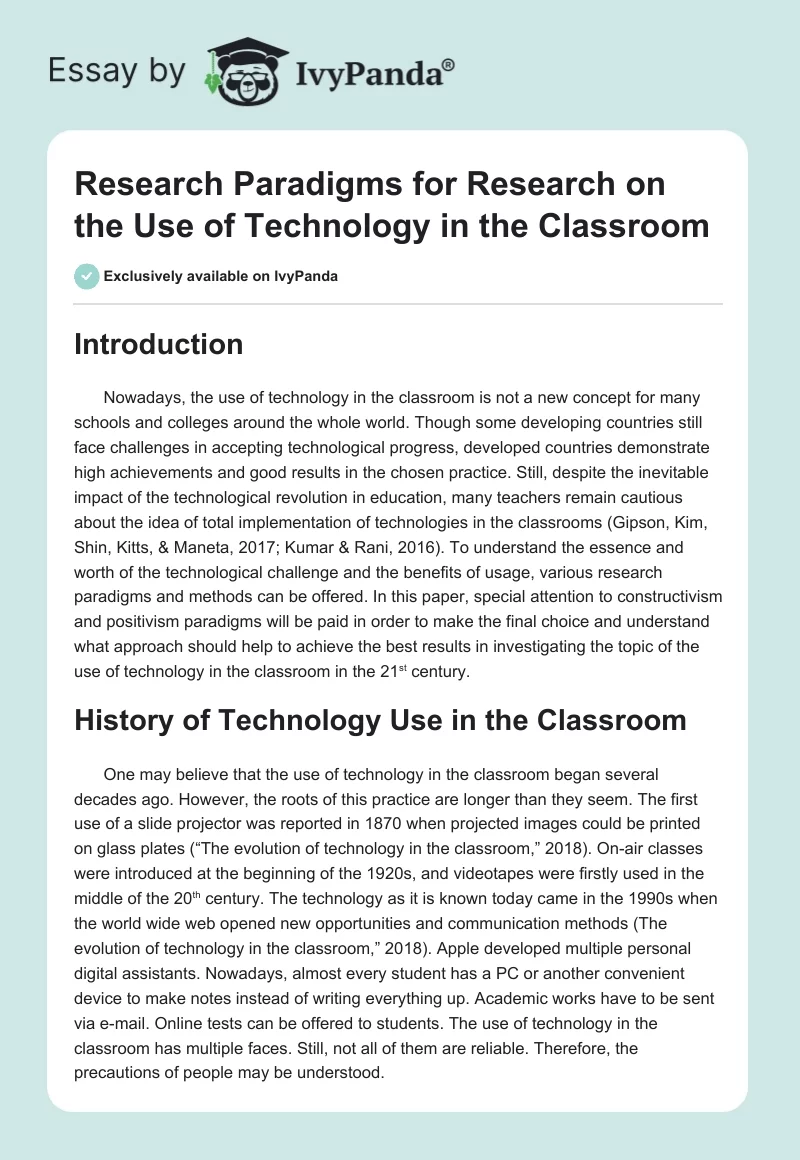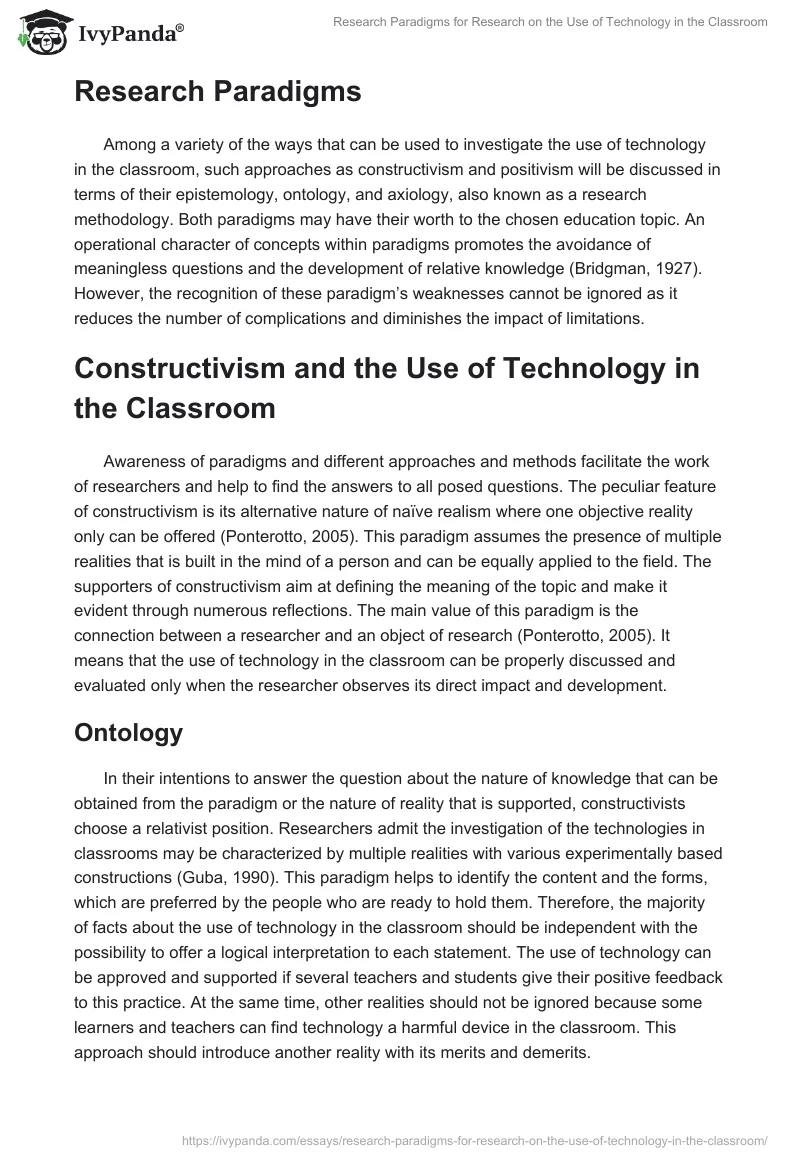Introduction
Nowadays, the use of technology in the classroom is not a new concept for many schools and colleges around the whole world. Though some developing countries still face challenges in accepting technological progress, developed countries demonstrate high achievements and good results in the chosen practice.
Still, despite the inevitable impact of the technological revolution in education, many teachers remain cautious about the idea of total implementation of technologies in the classrooms (Gipson, Kim, Shin, Kitts, & Maneta, 2017; Kumar & Rani, 2016). To understand the essence and worth of the technological challenge and the benefits of usage, various research paradigms and methods can be offered. In this paper, special attention to constructivism and positivism paradigms will be paid in order to make the final choice and understand what approach should help to achieve the best results in investigating the topic of the use of technology in the classroom in the 21st century.
History of Technology Use in the Classroom
One may believe that the use of technology in the classroom began several decades ago. However, the roots of this practice are longer than they seem. The first use of a slide projector was reported in 1870 when projected images could be printed on glass plates (“The evolution of technology in the classroom,” 2018). On-air classes were introduced at the beginning of the 1920s, and videotapes were firstly used in the middle of the 20th century.
The technology as it is known today came in the 1990s when the world wide web opened new opportunities and communication methods (The evolution of technology in the classroom,” 2018). Apple developed multiple personal digital assistants. Nowadays, almost every student has a PC or another convenient device to make notes instead of writing everything up. Academic works have to be sent via e-mail. Online tests can be offered to students. The use of technology in the classroom has multiple faces. Still, not all of them are reliable. Therefore, the precautions of people may be understood.
Research Paradigms
Among a variety of the ways that can be used to investigate the use of technology in the classroom, such approaches as constructivism and positivism will be discussed in terms of their epistemology, ontology, and axiology, also known as a research methodology. Both paradigms may have their worth to the chosen education topic. An operational character of concepts within paradigms promotes the avoidance of meaningless questions and the development of relative knowledge (Bridgman, 1927). However, the recognition of these paradigm’s weaknesses cannot be ignored as it reduces the number of complications and diminishes the impact of limitations.
Constructivism and the Use of Technology in the Classroom
Awareness of paradigms and different approaches and methods facilitate the work of researchers and help to find the answers to all posed questions. The peculiar feature of constructivism is its alternative nature of naïve realism where one objective reality only can be offered (Ponterotto, 2005). This paradigm assumes the presence of multiple realities that is built in the mind of a person and can be equally applied to the field.
The supporters of constructivism aim at defining the meaning of the topic and make it evident through numerous reflections. The main value of this paradigm is the connection between a researcher and an object of research (Ponterotto, 2005). It means that the use of technology in the classroom can be properly discussed and evaluated only when the researcher observes its direct impact and development.
Ontology
In their intentions to answer the question about the nature of knowledge that can be obtained from the paradigm or the nature of reality that is supported, constructivists choose a relativist position. Researchers admit the investigation of the technologies in classrooms may be characterized by multiple realities with various experimentally based constructions (Guba, 1990). This paradigm helps to identify the content and the forms, which are preferred by the people who are ready to hold them.
Therefore, the majority of facts about the use of technology in the classroom should be independent with the possibility to offer a logical interpretation to each statement. The use of technology can be approved and supported if several teachers and students give their positive feedback to this practice. At the same time, other realities should not be ignored because some learners and teachers can find technology a harmful device in the classroom. This approach should introduce another reality with its merits and demerits.
Epistemology
The researchers who follow the constructivist approach gain benefits from a subjectivist position. Epistemologically, human experiences cannot be neglected even if they are opposite to each other. Though the opinions may not be approved or scientifically supported, their role is integral for research as they help to identify as many realities and approaches as possible. These underpinnings can influence data analysis and the choice of methods regarding the quality of information offered.
Research Methods
From the methodological point of view, constructivists prefer to use as many ideas and statements as possible to unit them within one consensus. Two aspects can be offered: hermeneutic and dialectic (Guba, 1990). On the one hand, there is a need to depict all constructions that are appropriate for the discussion of the use of technology in the classroom, including personal interest, background knowledge, and community impact (hermeneutic approach).
On the other hand, comparison and contrast of the constructions should promote the identification of new aspects of this use (dialectic approach). Narrative approaches, ethnography, and grounded theory are the methods to gather and interpret information. Interviews, experiences, and observations can be offered to identify the benefits and shortages of technology in education in this case.
Strengths and Weaknesses
The main benefits of the chosen paradigm are direct access to a variety of opinions and statements where all of them have a meaning and the possibility to develop formulations regarding personal attitudes only. Other pros of this paradigm are the promotion of responsibility for each reaction, an understanding of potential limitations, the use of the subjective nature of human experiences, and open-mindedness during research.
However, constructivism usually does not provide something new on the subject. It helps to gather evident material and current thoughts on the topic. Another shortage is the intention to choose the easiest and most primitive answer or statement. The illusion of professionalism can be developed without the possibility to achieve actual progress.
Positivism and the Use of Technology in the Classroom
Positivism is another significant paradigm that can be used in the investigation of the use of technology in the classroom. It is one of the oldest branches of philosophy the goal of which to identify what actually happens and how the chosen practice or subject can work.
Though one may think that positivists and constructivists have many similarities, such a thought should never be taken for granted. Positivism and constructivism remain two rather different paradigms, and their core difference lies in the facts that can be gathered to prove the idea (Ponterotto, 2005). Positivism is based on observable and measurable facts with no subjective experiences being developed.
Ontology
Similar to constructivists, positivists support the realist type of ontology. They state that the reality depends on the existing natural laws and already approved mechanisms. The main belief of the supporters of this paradigm is that there is one reality in terms of which science can be used to predict and explain hypotheses. Laboratory experiments, direct participation in activities, and actual social processes with their positive and negative outcomes can be used to prove the idea. The use of technology can be checked within classrooms, relying on the results of students’ and teachers’ experiences and attitudes.
Epistemology
From the epistemological perspective, positivists believe in sensory information that can be defined as true knowledge only. Objectivist epistemology is the core issue of the paradigm under discussion. A researcher has to remove all potential threats that can influence the results of the investigation, including biases, values, and abilities. It is necessary to create similar conditions for all people who possess the same level of knowledge and skills and check the effectiveness of technologies in classrooms from one objective point of view.
Research Methods
To evaluate their work, positivists use empirical experimentalism. This method helps to pose questions and develop hypotheses in order to come to the same conclusion at the end of the research. The peculiar feature of the positivist methodology is that an empirical approach is free from manipulations but focused on the nature of the issue, not on the opinion of the inquirer (Guba, 1990). In other words, the methods of positivists help to identify the objective causes of human behavior with general and reliable explanations.
Strengths and Weaknesses
As well as any other research paradigm, positivism has its pros and cons. The benefits of this approach include the validity of information and the objectivity of research that is usually based on precise methods. The shortage of positivism is the inability to promote a full understanding of the topic. Participants are introduced as social products. Therefore, even if biases and attitudes have to be removed, society plays the role of a potential bias that promoted determined views.
Conclusion
Taking into consideration the main aspects of the two chosen paradigms, constructivism turns out to be the best approach to investigate the use of technology in the classroom and define the attitudes of the people who are involved in a learning process.
In addition, to maintain subjective points of view and identify as many realities as possible, constructivists promote the idea that it is normal for one concept to cause various reactions. Technology has many supporters, as well as opponents. Some people enjoy the progress to which modern society has access. However, it is also necessary to admit the opinions of people who are not ready to use technologies under certain conditions.
To conclude, both constructivism and positivism can answer the question about the worth of technology in the classroom. Still, the constructivist approach seems to be more credible and accurate because it helps not to put a full stop to the investigation, but to gather as many opinions as possible in order to create the same optimal conditions for all people. The solution offered by constructivism is characterized by increased opportunities compared to the positivist approach in terms of the investigation of technologies in modern classrooms.
References
Bridgman, P. (1927). The logic of modern physics. New York, NY: Macmillan.
Gipson, S. Y. M. T., Kim, J. W., Shin, A. L., Kitts, R., & Maneta, E. (2017). Teaching child and adolescent psychiatry in the twenty-first century: A reflection on the role of technology in education. Child and Adolescent Psychiatric Clinics, 26(1), 93-103. Web.
Guba, E. G. (Ed.). (1990). The paradigm dialog. Thousand Oaks, CA: SAGE.
Kumar, S., & Rani, M. (2016). Attitude of teachers towards the use of technology and innovation in the classroom.International Journal of Research in IT and Management, 6(11), 26-34. Web.
Ponterotto, J. G. (2005). Qualitative research in counseling psychology: A primer on research paradigms and philosophy of science. Journal of Counseling Psychology, 52(2), 126-136. Web.


